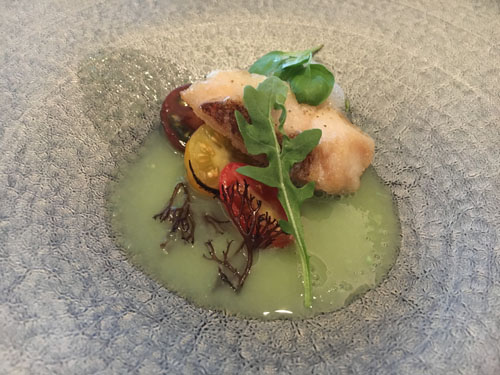Greg De St. Maurice
Culinary Borderlands and National Cuisines:
A Case Study of Japanese Cuisine
(18/07/2017)

My research project as the 2017 Air Liquide fellow, examines the discourse about Japanese cuisine and its iterations abroad through the lens of borders. Borders and boundaries may not affect cuisines in ways that are as clear or obvious as they are for agricultural products and foods, they are nonetheless impactful. Cuisines are often linked to a place of origin, as with Oaxacan, Szechuan, and new Nordic cuisines. In popular and scholarly discourse these cuisines are construed as forged in places that determined their distinguishing characteristics. Restaurants across the world that claim to serve “vera pizza Napoletana” or “authentic Bengali cuisine,” for example, index the place where the original and most authentic cuisine is perceived to exist.
I conducted my previous research at what is considered to be the capital of Japanese traditional culture—including gastronomy—Kyoto city. My current project shifts the focus to locations far outside of Japan. Several weeks ago, my research brought me to n / naka, the restaurant of chef Niki Nakayama, who describes her cuisine as “California kaiseki.” Framing her culinary style in this way directly channels Japan’s haute cuisine without claiming that the food is “Japanese.” The agemono course I was served represents this well: fried rock fish, tomato, ogo, verbena foam, with a tomatillo sauce that is carefully added to the dish in front of each guest.
n / naka may stand out for the acclaim it has received, but the appeal of restaurants serving Japanese-inspired food is an international trend. Sushi, ramen, and other Japanese dishes have gained popularity across the globe (Solt 2014, Kushner 2012, Bestor 2001). Japan’s Ministry of Agriculture, Forestry and Fisheries, estimates that in 2015, the number of restaurants claiming to serve Japanese food outside of Japan had risen to 89,000, an increase of 60% over an 18 month period. An international survey conducted by the Japanese External Trade Organization, meanwhile, determined that Japanese cuisine had become the most popular national cuisine. UNESCO has registered washoku, translated as the “traditional dietary cultures of the Japanese,” on its list of intangible cultural heritage in 2013. Meanwhile, the notion of the “Japanese diet” and more local variants (the “Okinawan diet,” e.g.) have been garnering more attention in the wake of the popularity of the Mediterranean diet and other healthy “traditional” cuisines.

This project will contribute new knowledge to the scholarship about Japanese foodways. Building upon the scholarly literature that focuses on the historical trajectory of specific Japanese foods (Bestor 2001, Kushner 2012, Solt 2014, Wank 2015, Brau 2004) and research that approaches contemporary conceptions of Japanese cuisine / foodways from a critical perspective (Cwiertka 2006, Rath 2016, Osawa forthcoming, Imai 2004), the focus on conceptions of Japanese cuisine, “place,” and borders outside of Japan will add a new dimension.
“Place” is also an important concept in the Japanese gastronomic world, with many cities and regions considered have their own “taste” (de St. Maurice 2012). Discourses about Japanese cuisine more generally touch upon contributing factors including climate (in particular “four distinct seasons” and a fermented-food friendly humidity) and topographical diversity (“land and sea” and the range of resources available from Hokkaido to Okinawa). Moreover, it is said that one distinguishing feature of Japanese cuisine is its valorization of seasonality, evidenced by its attentiveness to ingredients coming into season (hashiri), at their peak (shun), and on their way out of season (nagori). Naturally, this means that washoku and Nihon ryōri vary from locality to locality in tandem with the diversity of ingredients available and in season, as well as local taste preferences and differences in food culture. Hence the many food maps that exist in Japan giving visual representation to Japanese food culture by charting variations in miso, dashi, and even locally available fish species.
When transferred abroad, of course, the diversity of a nation’s foodways tend to be amalgamated into a shallow but broad category that could be termed a “national cuisine.” Pioneer food anthropologist Sidney Mintz argues that the category “national cuisine” for him is a “contradiction in terms” and only exists in terms of “restaurant food” whose artificiality comes form the involvement of the nation state and is essentially “an aggregation of foods, styles, cooking methods and signature dishes from the regional cuisines.” For Mintz, a cuisine requires “common social roots,” which implies an organic emergence from the bottom up. Contemporary communities, however, need not be place-based or “local,” but can be spread out, connected “virtually” via new technologies (Boellstorff 2008), for instance, in a contemporary version of “imagined communities” (Anderson 1983). A perspective that attends to how individual citizens participate in large-scale discursive communities might allow for the possibility of the emergence of a national cuisine, not as one that exists because it is created from the top down, but rather because such a concept can take hold and be shaped and re-shaped by communities that find it meaningful and economically productive.
Mintz may argue that a cuisine has to be organic and produced discursively by a specific community consisting of “a population that eats that cuisine with enough frequency to consider themselves experts in it,” “people that believe and care that they believe, that they know of what it consists, how it is made, and how it should taste,” I don’t believe that the scale must be limited to a region.
If one believes that a cuisine can genuinely exist at a larger scale, however, one has to consider how cuisines evolve as they occupy more geographical territory. Within a cuisine’s place of origin, certain types and degrees of innovation are deemed acceptable and desirable. Dishes that would have been unthinkinkable in this place of origin are invented outside of it, sometimes labeled “fusion,” other times decried as misinterpretation or appropriation.
A field of discourse is heterogenous and caught up in identity politics and power relations. This project focuses on the overlap and discrepancies between the discourse on Japanese cuisine within Japan (including that directed at foreign audiences) and that occurring outside of Japan (including discourses produced by Japanese actors and those with training in Japanese cuisine living and working abroad). I am especially interested in questions related to which criteria and which actors are considered to have the authority to determine what counts as Japanese cuisine in different contexts. Another key concept will be innovation and how different actors may be allowed to innovate more than others. I will also consider whose interests are served by the dominant discourses related to what counts as genuine Japanese cuisine.

For this research, I am conducting interviews with actors inside and outside of Japan promoting and disseminating knowledge of Japanese foodways and gathering relevant texts for discourse analysis. Sources inside Japan include the Ministry of Agriculture, Forestry and Fisheries (the institution that submitted the successful UNESCO application), the Japanese Culinary Academy (a non-profit organization composed of influential chefs and food researchers), the Umami Information Center (dedicated to spreading knowledge of umami and Japanese foodways abroad), and Washoku Kokumin Kaigi (a group focused on promoting traditional Japanese foodways domestically). Outside of Japan, my focus is on foreign chefs, bloggers, film directors, and event organizers. Because recent increases in Japanese restaurants there, Paris and Toronto are my two main field sites. At a later stage, I will also look to Los Angeles, New York City, London, and Milan for similarities and differences.
Participant observation in settings and at events promoting washoku in Japan, France, and Canada will serve as an additional source of data. This will include attending traditional cooking classes for local citizens and tourists in Japan, symposia and conference panels about washoku, as well as company or product specific promotion events.
References
Anderson, Benedict. 1983. Imagined Communities: Reflections on the Origin and Spread of Nationalism. London: Verso.
Bestor, Theodore. 2001. “Supply-side Sushi: Commodity, Market, and the Global City.” American Anthropologist 103 (1): 76-95.
Boellstorff, Tom. 2008. Coming of Age in Second Life: An Anthropologist Explores the Virtually Human. Princeton: Princeton University Press.
Brau, Lorie. 2004. “Oishinbo's Adventures in Eating: Food, Communication, and Culture in Japanese Comics.” Gastronomica 4 (4):34-45.
Cwiertka, Katarzyna. 2006. Modern Japanese Cuisine: Food, Power, and National Identity. London: Reaktion Books.
Cwiertka, Katarzyna. 2001. “Japanese Food in Holland: The global Trend Spreads." Food Culture 3:15-19.
de St. Maurice, Greg. 2012. "Savoring Kyoto: Sensory Fieldwork on the Taste of Place." Etnofoor 24 (2):110-122.
Kushner, Barak. 2012. Slurp!: A Social and Culinary History of Ramen - Japan's Favorite Noodle Soup. Leiden; Boston: Global Oriental.
Imai, Shoko. 2015. “Umami Abroad: Taste, Authenticity, and the Global Urban Network.” In The Globalization of Asian Cuisines: Transnational Networks and Culinary Contact Zones, edited by James Farrer, 57-78. New York: Palgrave MacMillan.
Mintz, Sidney W. 1996. Tasting Food, Tasting Freedom: Excursions into Eating, Culture, and the Past. Boston: Beacon Press.
Rath, Eric. 2016. Japan's Cuisines: Food, Place and Identity. London: Reaktion Books.
Rath, Eric C. 2010. Food and Fantasy in Early Modern Japan. Berkeley: University of California Press.
Ray, Krishnendu. 2016. The Ethnic Restaurateur. London; New York, NY: Bloomsbury.
Solt, George. 2014. The Untold History of Ramen: How Political Crisis in Japan Spawned a Global Food Craze. Berkeley: University of California Press.
Wank, David, and James Farrer. 2015. “Chinese Immigrants and Japanese Cuisine in the United States: A Case of Culinary Glocalization." In The Globalization of Asian Cuisines: Transnational Networks and Culinary Contact Zones, edited by James Farrer, 79-99. New York, NY: Palgrave Macmillan. |











